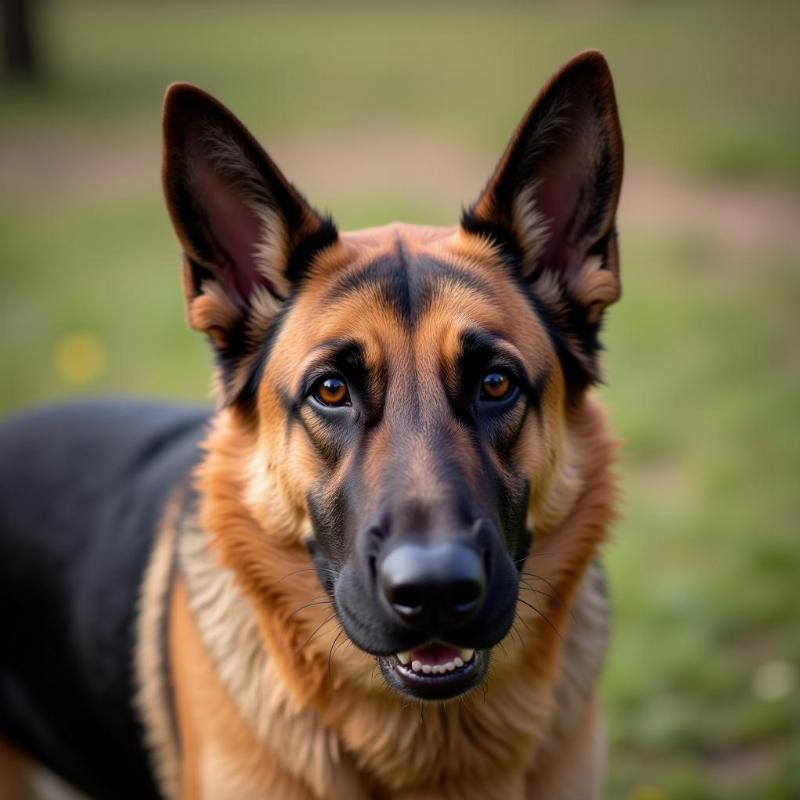Raised hackles, also known as piloerection, is a common canine behavior where the hair on a dog’s back stands up. While often associated with aggression, raised hackles aren’t always a sign of impending attack. Understanding the context surrounding this behavior is crucial for dog owners in the US. This article delves into the various dog breeds that might exhibit raised hackles, the reasons behind this behavior, and how to interpret it correctly.
Decoding Raised Hackles: More Than Just Aggression
Many dog breeds, from Chihuahuas to German Shepherds, can raise their hackles. It’s a physiological response triggered by the sympathetic nervous system, similar to goosebumps in humans. While some breeds may be more prone to exhibiting this behavior due to their temperament or genetic predisposition, raised hackles are not breed-specific. It’s important to remember that raised hackles are a form of communication, signaling a heightened emotional state, not necessarily aggression.
 German Shepherd with raised hackles
German Shepherd with raised hackles
Common Reasons for Raised Hackles in Dogs
Several factors can cause a dog to raise its hackles. Fear, excitement, arousal, and even uncertainty can trigger this response. A dog encountering a new person, hearing a loud noise, or engaging in playful roughhousing might display raised hackles. Distinguishing between these contexts requires careful observation of the dog’s overall body language, including its posture, facial expressions, and vocalizations.
Fear and Anxiety
When a dog feels threatened or anxious, raised hackles can be a defensive mechanism. The raised fur makes the dog appear larger, potentially deterring a perceived threat. This is often accompanied by tucked tail, flattened ears, and whale eyes (where the whites of the eyes are visible). Understanding these subtle cues is critical to ensuring the dog’s safety and well-being.
Excitement and Arousal
Raised hackles can also indicate excitement and arousal, especially during play or when anticipating something enjoyable, like a walk or a treat. In these situations, the raised hackles are usually accompanied by a wagging tail, relaxed posture, and playful vocalizations.
Uncertainty and Ambivalence
Sometimes, raised hackles signal uncertainty or ambivalence. The dog might be unsure how to react in a particular situation, resulting in a mixed display of signals. This can occur when meeting new dogs or encountering unfamiliar objects. Careful observation and providing a safe, supportive environment can help the dog navigate these situations.
Responding to a Dog with Raised Hackles
When encountering a dog with raised hackles, it’s crucial to avoid making sudden movements or direct eye contact, which can be perceived as threatening. Speaking calmly and softly can help diffuse the situation. Giving the dog space and allowing it to approach on its own terms is essential. If the dog continues to display signs of aggression or discomfort, it’s best to seek professional guidance from a certified dog trainer or behaviorist.
What to Do if Your Dog Raises Its Hackles
If your own dog raises its hackles, observe its overall body language to determine the underlying emotion. If it’s fear or anxiety, try to remove the trigger or provide comfort and reassurance. If it’s excitement, redirect the energy into appropriate play or activity. If you’re unsure of the cause, consult with a veterinarian or certified dog trainer.
Conclusion
Understanding the nuances of canine body language, including raised hackles, is essential for responsible dog ownership in the US. While raised hackles can be a sign of aggression, they are often an indicator of other emotional states. By paying attention to the context and accompanying signals, you can accurately interpret your dog’s behavior and ensure a positive and safe interaction. Remember, a well-informed dog owner is a better advocate for their furry companion.
FAQ
- Do all dog breeds raise their hackles? Yes, all dog breeds have the capacity to raise their hackles. It’s a physiological response, not a breed-specific trait.
- Are raised hackles always a sign of aggression? No, raised hackles can indicate various emotions, including fear, excitement, and uncertainty.
- What should I do if a strange dog raises its hackles at me? Avoid sudden movements or direct eye contact. Speak calmly and give the dog space.
- How can I tell if my dog’s raised hackles are due to fear or excitement? Observe the dog’s overall body language, including posture, facial expressions, and tail position.
- Should I be concerned if my dog frequently raises its hackles? If your dog frequently raises its hackles, it’s best to consult with a veterinarian or certified dog trainer to determine the underlying cause and address any potential behavioral issues.
- Can training help a dog control its hackle-raising response? Yes, with proper training and behavior modification, dogs can learn to manage their emotional responses, including raising their hackles.
- Are there any specific health conditions associated with raised hackles? While raised hackles themselves are not a health condition, they can be a symptom of underlying anxiety or stress.
Beautdogs.us is your premier online destination for comprehensive and engaging information on dog care, breeds, and products in the US. Whether you’re a new dog owner or a seasoned expert, Beautdogs.us provides expert advice and resources to help you navigate the joys and challenges of dog ownership. We offer a wealth of information on dog breeds, training tips, health advice, and product recommendations to ensure your furry friend receives the best care possible. Contact us today for all your dog-related needs! Email: [email protected], Phone: +1 501-555-7529. Beautdogs.us is committed to helping you build a strong and loving bond with your canine companion.